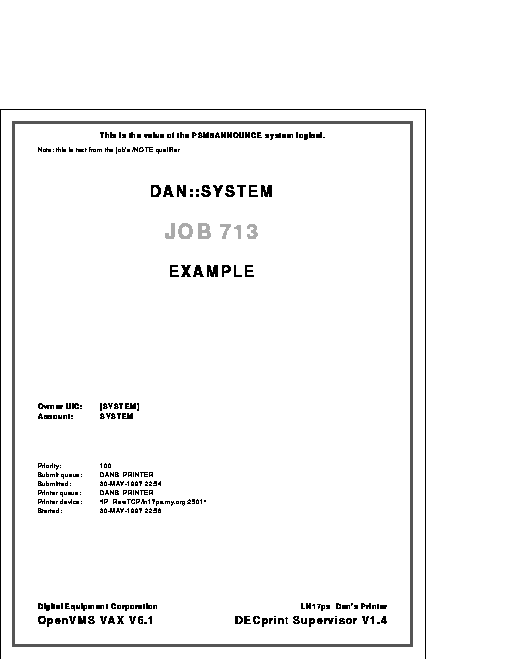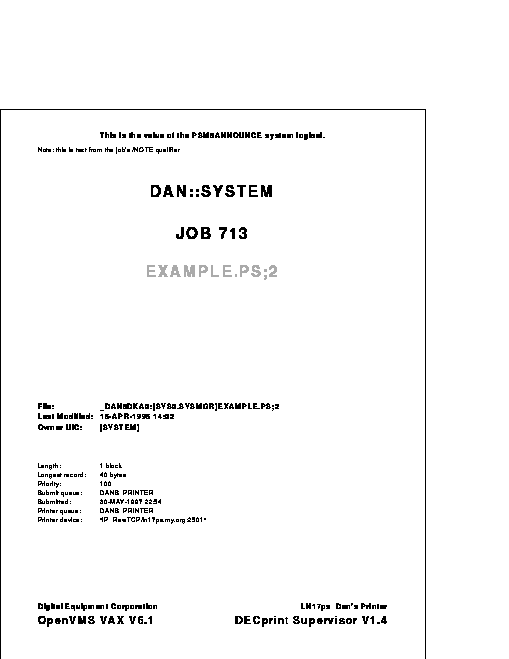| Previous | Contents | Index |
Separation pages are sheets that show where a user's print job or each file in a print job begins and ends. Separation pages include:
A job flag page looks like a job burst page without the border around the page. A job trailer page looks like a job flag page with the message "END OF JOB" printed at the top and with additional information listed for the job (for example, when it finished, which PRINT qualifiers and parameters were used, and how many pages were printed). File separation pages are differentiated from each other in an analagous fashion, and from job separation pages by the presence of file-specific information (for example, the file specification, file size, and modification time).
You can enable separation pages for print jobs and each file in a print job. The following sections show you how.
6.2 Enabling Job Separation Pages
Job separation pages keep print jobs
separate. Figure 6-1 shows one type of job separation page; a job
burst page.
Figure 6-1 A Job Burst Page

You enable and disable job separation pages by editing the DCPS$STARTUP.COM file; the user cannot override these settings.
Enter the /SEPARATE qualifier to parameter 5 in the execution queue entry in DCPS$STARTUP.COM, as shown here:
@sys$startup:dcps$execution_queue -
DCPS_TTB4 - ! P1 - Execution queue name
"SERIAL/TTB4" - ! P2 - Device name
DCPS_LIB - ! P3 - Logical name for /LIBRARY
"" - ! P4 - Default queue parameters
"/SEPARATE=(BURST,NOFLAG,TRAILER)"
! P5 - Default queue qualifiers
|
Notes:
$ SET QUEUE/SEPARATE=(BURST,NOFLAG,TRAILER) queuename |
If the print job contains errors, the trailer page includes messages that can help the user determine what went wrong with the print job. Following are examples of these messages:
28-MAR-2000 11:03 %DCPS-I-TRAYSUBST, Output will be delivered to the only tray on printer-name |
28-MAR-2000 11:03 %DCPS-W-INVACC, invalidaccess: Attempt to access restricted object or capability - offending command is get |
These types of messages are also displayed on the user's terminal if /NOTIFY was specified in the PRINT command for the print job.
The following types of messages are not printed on the job trailer page:
DCPS normally prints a job trailer page if errors occur during the job, even if /SEPARATE=TRAILER is not specified for the queue, as mentioned in sections Section 6.2 and Section 6.2.1. This behavior may be undesireable when printing on expensive media, especially if the reported errors are unimportant.
To prevent DCPS from printing job trailers, even when errors occur for the job, define the following system-wide logical:
$ DEFINE/SYSTEM/EXECUTIVE DCPS$queuename_SUPPRESS_JOBTRAILER 1 |
Running DCPS this way makes it much more difficult to diagnose real problems when they arise. If you are getting nuisance error messages, Compaq recommends that you resolve the underlying problem rather than suppressing the messages. |
When users print jobs on expensive or special media, it may be desirable to print job burst and flag pages from a special input tray. This technique is also useful for specifying a different color paper for separating print jobs.
With the DCPS--PLUS license, you may specify a special input tray for job flag pages and job burst pages. Define a logical name using the following command:
$ DEFINE/SYSTEM/EXECUTIVE DCPS$queuename_SEPARATOR_TRAY n |
In this command, queuename is the name of the execution queue
and n is the PostScript input tray number. The tray numbers
are specific to your printer model and may be listed in your printer
owner's manual.
6.3 Enabling File Separation Pages
File separation pages separate the files in the print job. Figure 6-2 shows an example of a file flag page.
Figure 6-2 A File Flag Page

To enable default file separation pages, do the following:
Users can override the default file flag, burst, and trailer attributes for a queue by specifying the /[NO]FLAG, /[NO]BURST, and /[NO]TRAILER qualifiers in the PRINT command.
In the following example, each file in the job will be preceded by a file flag page and followed by a file trailer page:
$ PRINT/FLAG=ALL/TRAILER=ALL FILE1.PS,FILE2.PS,FILE3.PS |
If the PAGE_LIMIT parameter is used in the PRINT command, or if the print job is terminated, the file flag page and file trailer page may not be printed. |
You can add a system message to the top of job and file burst, flag, and trailer pages for all jobs printed on your system. The following example shows you how:
$ DEFINE/SYSTEM/EXECUTIVE PSM$ANNOUNCE "Computer Services Group" |
The example shows that the logical name PSM$ANNOUNCE is now "Computer Services Group".
The PSM$ANNOUNCE logical is used by other print symbionts (for example, LATSYM) as well as by the DCPS symbiont. Your definition of PSM$ANNOUNCE will also affect these other symbionts. |
A job log page is an optional sheet with information about the print
job and any messages that occurred during the print job. Use the
MESSAGES=PRINT parameter in the PRINT command to print a job log page.
When printed, the job log page precedes the job trailer page. If you
are not printing job trailer pages, the job log page is the last page
of a job.
6.6 The File Error Page
If the software cannot access the print file when the print job starts printing, a file error page is printed and the software continues with the next file in the print job (if any).
The file error page contains the following information:
A setup module is a file containing instructions that modify the appearance of a print job or redefine the instructions in the print job.
You can include a setup module in a print job with the PRINT command's /SETUP qualifier. The following example uses a setup module that specifies 600 dots-per-inch (DPI) resolution:
$ PRINT/QUEUE=LPS32$2SIDES/SETUP=RES_600X600 IMAGE.PS |
You can also implicitly include setup modules in a print job through
the use of a form (see Chapter 8).
7.2 Locating Setup Modules
DECprint Supervisor ships with various setup modules, which are located in the following device control library:
SYS$LIBRARY:DCPS$DEVCTL.TLB
To list the setup modules, use the following command:
$ LIBRARY/LIST SYS$LIBRARY:DCPS$DEVCTL.TLB |
The list of setup modules displays, similar to the following:
DCW1000_DISPLAY DCW1000_ENHANCED DCW1000_HIGHRES LPS$$APPLE360_INITPSDEVICE LPS$$APPLE360_SETINPUTTRAY RES_1200X1200 RES_1200X600 |
Do not modify any of the setup modules or the device control library. |
Some setup modules are created only for certain printers. Those setup modules have the printer name as part of their file name. For instance, the setup module DL3500_RET_DARK is intended for the DEClaser 3500 printer.
Do not change the contents of the standard supplied device control library. |
Custom setup modules go in special device control libraries, which are required to be .TLB (text library) files located in SYS$LIBRARY. The following command lists all of the text libraries in SYS$LIBRARY. To determine what subset of these are special device control libraries used with DCPS, correlate the .TLB file names with the libraries and library search lists associated with the /LIBRARY qualifier for your system's DCPS print queues.
$ DIRECTORY SYS$LIBRARY:*.TLB |
To see the instructions that a setup module contains, do the following:
$ LIBRARY/EXTRACT=(DI_ON)/OUT=MYSETUP SYS$LIBRARY:DCPS$DEVCTL.TLB |
$ TYPE MYSETUP.TXT |
%!
% ~~~~~~~~~~ DI_on ~~~~~~~~~~
statusdict begin false setDECimage end
systemdict /languagelevel known {languagelevel} {1} ifelse
2 ge {currentpagedevice /Install get exec} if
statusdict begin true setDECimage end
% ~~~~~~~~~~~~~~~~~~~~~~~~~~~
|
Some setup modules contain escape sequences or graphics, which cannot be displayed when you type the file. For such modules, you may wish to use the DUMP/RECORD command on the extracted file. |
You can create setup modules that affect print jobs with different data types. Some setup modules manipulate ANSI print jobs, while others affect PostScript jobs. You can create setup modules for any data type you support.
Notes:
To make the setup module accessible to users, you must create a device control library and put the module in the library. Create a different library for setup modules of each data type. Do not include setup modules of different data types in the same library. You can create a library for ANSI, PCL, Proprinter, or PostScript files.
Do not put your custom setup modules in the standard DCPS$DEVCTL library. Custom setup modules in DCPS$DEVCTL will be deleted if you upgrade DECprint Supervisor software. |
To create a library for setup modules, use the following command format:
$ LIBRARY/CREATE/TEXT SYS$COMMON:[SYSLIB]library-name.TLB |
You supply the library-name, the name you give to the library.
The following command creates a new PostScript device control library, PS1, for your customized PostScript setup modules:
$ LIBRARY/CREATE/TEXT SYS$COMMON:[SYSLIB]PS1.TLB |
For more information, refer to the OpenVMS Librarian Utility Manual.
7.4.1 Putting Setup Modules in Libraries
To insert a setup module into a device control library, use the following command format:
$ LIBRARY/INSERT SYS$LIBRARY:library-name.TLB module-name |
In the command line, you supply the following information:
| library-name | The name of the library |
| module-name | The name of the setup module |
The following command puts the PostScript setup module, CONFIDENTIAL.PS, into your PostScript device control library, PS1.TLB, and names the setup module CONFIDENTIAL:
$ LIBRARY/INSERT SYS$LIBRARY:PS1.TLB CONFIDENTIAL.PS |
The following command puts the ANSI setup module, A4_PAGE.TXT, into your ANSI device control library, ANSI1.TLB, and names the setup module A4_PAGE:
$ LIBRARY/INSERT SYS$LIBRARY:ANSI1.TLB A4_PAGE.TXT |
If you have several device control libraries, you need to set up a search list of the libraries in SYS$STARTUP:DCPS$STARTUP.COM. The search list specifies which device control libraries to search, and the priority of the libraries.
Example 7-1 shows a search list of device control libraries.
| Example 7-1 Search List for Device Control Libraries |
|---|
$ DEFINE/SYSTEM/EXECUTIVE/NOLOG DCPS_LIB -
DCPS$DEVCTL,-
"PS1/DATA_TYPE=POSTSCRIPT",-
"ANSI1/DATA_TYPE=ANSI",-
PS2
|
In Example 7-1, the software does the following:
To define your library logical name and search list, perform the following steps:
| Command Line | Example |
|---|---|
$ DEFINE/SYSTEM/EXECUTIVE/NOLOG - |
$ DEFINE/SYSTEM/EXECUTIVE/NOLOG DCPS_LIB - |
REQMODNOTFOUND, Required device control module module-name not found |
All device control libraries specified for a queue must exist for the queue to start. For example, if a queue is defined with the following logical, the libraries SYS$LIBRARY:DCPS$DEVCTL.TLB, SYS$LIBRARY:ANSI.TLB and SYS$LIBRARY:PS.TLB must all exist as text libraries:
$ DEFINE/SYSTEM/EXECUTIVE DCPS_LIB -
DCPS$DEVCTL, -
"ANSI/DATA_TYPE=ANSI", -
"PS/DATA_TYPE=POSTSCRIPT"
|
When you install DECprint Supervisor software, it creates a new version of the standard device control library (DCPS$DEVCTL.TLB). If you purged old files during the software installation, early copies of the device control library are deleted. (Refer to the Software Installation GuideSoftware Installation Guide for more information.)
When you add custom setup modules, create a new library and refer to it in the library search list. This preserves your custom setup modules when you upgrade your software.
Upgrading from DECprint Printing Services or PrintServer Client Software
DECprint Printing Services software and PrintServer Client software have their own device control libraries (CPS$DEVCTL.TLB and LPS$DEVCTL.TLB). When you upgrade to DECprint Supervisor, the CPS$ and LPS$ device control libraries are no longer used. If you have custom setup modules in either of those libaries, insert the modules into a new library and specify the library in the device control library search list.
| Previous | Next | Contents | Index |